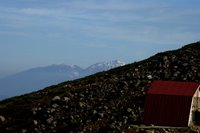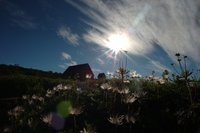Hokkaido Mountain Huts
 The cliffs at the bottom of the gorge were steeper than I thought, and it was touch and go for about an hour, punching holes in the snow-pack and hanging on to any shrub I could find, hoping the whole face wasn’t about to slip-slide away into the stream below, dog-tired, and the sun way past gone down over the jagged tri-peaks of Mt. Ashibetsu. Meanwhile, farther up the ridge, Ryan was slogging through waist-high powder only a stones throw from the cabin where we hoped to spend the night, but it wasn't until he descended into the ravine to find me, resigned to a teeth-chattering night in a snow-cave, that he stumbled upon a few feet of shiny stove-pipe protruding from a wind-blown drift.
The cliffs at the bottom of the gorge were steeper than I thought, and it was touch and go for about an hour, punching holes in the snow-pack and hanging on to any shrub I could find, hoping the whole face wasn’t about to slip-slide away into the stream below, dog-tired, and the sun way past gone down over the jagged tri-peaks of Mt. Ashibetsu. Meanwhile, farther up the ridge, Ryan was slogging through waist-high powder only a stones throw from the cabin where we hoped to spend the night, but it wasn't until he descended into the ravine to find me, resigned to a teeth-chattering night in a snow-cave, that he stumbled upon a few feet of shiny stove-pipe protruding from a wind-blown drift. But it all worked out in the end, as these things nearly always do, and it’s almost warm in here now. Ryan and I are lying in our sleeping bags, slurping down spaghetti, making noises like bears, faces buried down in the pot. We’ve got a fire going in the rusty tin-can stove, plenty of hot food and enough candlelight to write by.
 This is a big cabin, with heavy charcoal-black beams, thick stone walls and two-stories of sleeping bunks – but it’s totally buried in snow. Ryan had to shovel for 20 minutes before he could crawl through an upstairs window and lower himself down to the floor.
This is a big cabin, with heavy charcoal-black beams, thick stone walls and two-stories of sleeping bunks – but it’s totally buried in snow. Ryan had to shovel for 20 minutes before he could crawl through an upstairs window and lower himself down to the floor. Welcome to springtime in Hokkaido.
Everything is soaking wet, but we’re going to sleep well tonight. The pasta is finished, and there was homemade chili before that, with fat kidney beans and mounds of parmesan cheese. We’ve left the window open for ventilation, and can see three shivering stars in a patch of dark blue sky, the sound of the stream coming through too, like ten-thousand splintering icicles. I’ve got a bottle full of that stream water right next to my bag, water so cold it burns the whole way down.
 There are a lot of huts like this one in Hokkaido, tucked away in valleys and perched on ridges throughout some of the most gorgeous mountains in East Asia. A few of the more popular and accessible cabins charge for bunk space, but most are built and maintained by volunteers, left open year-round to anyone in need of a dry place to hang their socks and lay out a sleeping bag. Some shelters are downright luxurious, with tatami mat floors, magazines, stacks of blankets and well-stocked wood piles, while others are little more than flimsy lean-tos, but even the most humble hut is a welcome sight at the end of a long day on the trail.
There are a lot of huts like this one in Hokkaido, tucked away in valleys and perched on ridges throughout some of the most gorgeous mountains in East Asia. A few of the more popular and accessible cabins charge for bunk space, but most are built and maintained by volunteers, left open year-round to anyone in need of a dry place to hang their socks and lay out a sleeping bag. Some shelters are downright luxurious, with tatami mat floors, magazines, stacks of blankets and well-stocked wood piles, while others are little more than flimsy lean-tos, but even the most humble hut is a welcome sight at the end of a long day on the trail. Over a dozen shelters are scattered about Daisetuzan (Big Snow Mountains) National Park, a massive wilderness area in central Hokkaido.
 Some of the more comfortable cabins are conveniently positioned at remote trailheads, allowing weekend hikers to drive into the mountains on Friday afternoon and get an early start Saturday morning. Others boast natural hot spring pools a few steps from the front door, the perfect medicine for clammy skin and tired muscles. One of the most spectacular hikes in Hokkaido is a traverse of volcanic 2,000 meter peaks along the spine of Daisetuzan, a trek that can take a week to complete. Apart from a remote 25 km section of trail between Hisago Marsh and Mt. Biei-Fuji, shelters are available at most camping spots along the traverse, a welcome sight to backpackers eager to duck out of the wind and get a good nights sleep. Brewing tea from melted snow-water at daybreak on the porch of one of these cabins, watching steam boiling out of the river valleys far below, makes for mornings beautiful enough to break your heart - and heal it back again with each mist-cloud breath.
Some of the more comfortable cabins are conveniently positioned at remote trailheads, allowing weekend hikers to drive into the mountains on Friday afternoon and get an early start Saturday morning. Others boast natural hot spring pools a few steps from the front door, the perfect medicine for clammy skin and tired muscles. One of the most spectacular hikes in Hokkaido is a traverse of volcanic 2,000 meter peaks along the spine of Daisetuzan, a trek that can take a week to complete. Apart from a remote 25 km section of trail between Hisago Marsh and Mt. Biei-Fuji, shelters are available at most camping spots along the traverse, a welcome sight to backpackers eager to duck out of the wind and get a good nights sleep. Brewing tea from melted snow-water at daybreak on the porch of one of these cabins, watching steam boiling out of the river valleys far below, makes for mornings beautiful enough to break your heart - and heal it back again with each mist-cloud breath. Many cabins designed to accommodate large groups of hikers receive only a few visitors each season. Hokkaido, like much of rural Japan, is in the midst of economic doldrums so severe that several towns are being forced to merge with their neighbors in order to keep vital services up and running. Amid the belt-tightening, funds for access roads to the mountains are often the first to evaporate. When a landslide washes out a section of road (as happened recently on the Uryu side of Mt. Shokanbetsu and at Mt. Yubari) few weekend hikers bother to walk all the way to the trailhead, leaving the cabins there relatively unused. Anyone willing to extend their trip by a day to allow for the extra hike in and out along the access road will probably have the place to themselves – perfect for a large group of friends!
Many cabins designed to accommodate large groups of hikers receive only a few visitors each season. Hokkaido, like much of rural Japan, is in the midst of economic doldrums so severe that several towns are being forced to merge with their neighbors in order to keep vital services up and running. Amid the belt-tightening, funds for access roads to the mountains are often the first to evaporate. When a landslide washes out a section of road (as happened recently on the Uryu side of Mt. Shokanbetsu and at Mt. Yubari) few weekend hikers bother to walk all the way to the trailhead, leaving the cabins there relatively unused. Anyone willing to extend their trip by a day to allow for the extra hike in and out along the access road will probably have the place to themselves – perfect for a large group of friends! Sharing a cabin with strangers can also be a rewarding experience. The Japanese people I’ve met in the mountains have overwhelmed me with generosity more times than I can remember. If you’re friendly and considerate, or just look a bit bedraggled, don’t be surprised to receive rice-balls, hot tea, sips of whiskey and pale pink processed fish sausage from Japanese hikers delighted to come across foreigners in the backcountry.
 This being Japan, even the most heavily used cabins are kept clean and well-maintained, with little conveniences laid out for hikers in advance. Dry kindling arranged in the stove is a beautiful thing to see when arriving at a shelter cold and wet. It’s important to respect the cooperative spirit that these cabins represent, so make sure to leave them in even better condition than when you arrived. Take special care to pack out all food scraps. Even a candy bar wrapper can attract animals – including brown bears!
This being Japan, even the most heavily used cabins are kept clean and well-maintained, with little conveniences laid out for hikers in advance. Dry kindling arranged in the stove is a beautiful thing to see when arriving at a shelter cold and wet. It’s important to respect the cooperative spirit that these cabins represent, so make sure to leave them in even better condition than when you arrived. Take special care to pack out all food scraps. Even a candy bar wrapper can attract animals – including brown bears! The hut we’re in now is sturdier than most, a good thing given the sheer amount of snow pressed against the walls. It’s hard to imagine a more dramatic location for a cabin, perched on a tiny patch of level ground at the top of a gorge and surrounded on three sides by sheer cliffs rising hundreds of meters to craggy peaks. In the summer, the trail up the gorge is passable – barely - but most hikers choose the safer route up the new trail, which follows a ridgeline and comes nowhere near this cabin.
 Clearly, April Fool's Day is a little too early to be here – if Ryan hadn’t happened to notice the stove pipe, we would be huddled in a snow-cave right now, and I’d be writing a very different story. Mountaineering season in Hokkaido doesn’t really start until June, and only experienced hikers should be on the trails in October, when winter storms can hit suddenly and hard. Even in high summer, it’s important to have warm clothes and a tarp, just in case Murphy’s Law asserts itself.
Clearly, April Fool's Day is a little too early to be here – if Ryan hadn’t happened to notice the stove pipe, we would be huddled in a snow-cave right now, and I’d be writing a very different story. Mountaineering season in Hokkaido doesn’t really start until June, and only experienced hikers should be on the trails in October, when winter storms can hit suddenly and hard. Even in high summer, it’s important to have warm clothes and a tarp, just in case Murphy’s Law asserts itself. Ryan’s asleep, the candles are sputtering and new stars have moved into the window. Tomorrow we’ll have a long slog up to the ridgeline, then back down to the conveniences of the valley. Right now, all I need is my down sleeping bag and a dry bunk in this universe of snow.
…………………………………………………………..
I will lead a 2-week travel program in Hokkaido in September, 2011, through Sterling College. More details here: Hokkaido Field Study.
Mt. Ashibetsu and the Daisetuzan traverse are described in the Lonely Planet’s guide to Hiking in Japan . If planning a trip to a remote cabin, it's a good idea to stop by an outdoor store or tourist information office to make sure that the trails are open and the cabin is still standing. Anyone with specific questions is welcome to contact me!
All the photos in this post were taken by Ryan Libre. You can see more of his work at Idioimagers.org.
Labels: Hokkaido


4 Comments:
Cracking photos.
Would love to do some hiking up north sometime, but fear it may have to wait for a while yet.
Nice to be taken there in words and photos, though.
Good photos and a good piece too.
Brought back a lot of memories. I've had some relatively hairy situations in Hokkaido's mountains in the height of summer. I can't imagine what they'd be like in April, let alone January or February.
Mountains don't get much better than in the Daisetsuzan park and Shiretoko.
Very impressed with the site and also the photos, not to mention the story. We "attempted" a hike around this area last October, but ended up sleeping on the bathroom floor of a campsite that had closed the weekend before.
Hey I realize this is a really old post...but you might be interested that I've started making a database of Hokkaido mountain huts. Haven't got to Yufure stone hut yet, but there are about 14 in the list now - https://hokkaidowilds.org/huts
Post a Comment
Subscribe to Post Comments [Atom]
<< Home